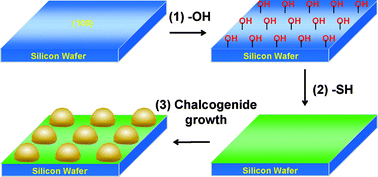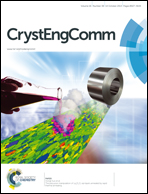Inducing nucleation and growth of chalcogenide nanostructures on silicon wafers†
Abstract
Surface-modification at the interface between inorganic surfaces and organic molecules plays a critical role in the growth of inorganic nanocrystals on prepatterned and flat/curved substrates. Herein, we have developed a general and versatile method for inducing the nucleation and growth of chalcogenide nanostructures on Si substrates by surface-modification. Monolayers of 3-mercaptopropyltriethoxysilane (3-MPTES) were used to induce the nucleation and growth of chalcogenide nanostructures from an aqueous solution at near room temperature. Terminal sulfhydryl groups (–SH) act as nucleation sites because of their strong coordination capacity to bind metal ions. Once the initial nuclei are formed on the surface of the Si substrate, the chalcogenide nanostructures can be formed through an ion-by-ion growth via ion diffusion in the liquid medium, resulting in the formation of a dense/stable layer of chalcogenide nanostructures. Meanwhile, the intercrystalline distances between the chalcogenide nanostructures can be adjusted by the surface density of 3-MPTES modified on the substrates. Furthermore, the present surface-modification strategy shows extremely mild growth conditions and good reproducibility. This inducing nucleation and growth strategy can be extended to fabricate other chalcogenide nanocrystals, including PbS nanocubes, Ag2S nanoparticals, CdS spherulites and Fe8S7 nanobelts, on silicon wafers. These substrate-arrays with semiconducting chalcogenide nanostructures can be used for the nanofabrication of electrodes, and electronic and nanophotonic devices.


 Please wait while we load your content...
Please wait while we load your content...